Abstract
Thirteen infants who had undergone 24 hour oesophageal pH monitoring to diagnose gastro-oesophageal reflux had a second study carried out to see if the results were reproducible. The studies were done without restricting the babies' activities. Appreciable differences were found, the percentage of the total time during which the pH was less than 4 varying by up to 3.7-fold between the two tests. The differences were largely the result of biological rather than technical variability. From these results estimates were made of the reliability of a single diagnostic study and the size of changes that would be necessary to show the effect of treatment. These findings have a considerable impact on the diagnosis of abnormal gastro-oesophageal reflux and its response to treatment whether using 24 hour pH monitoring or any other method of measurement.
Full text
PDF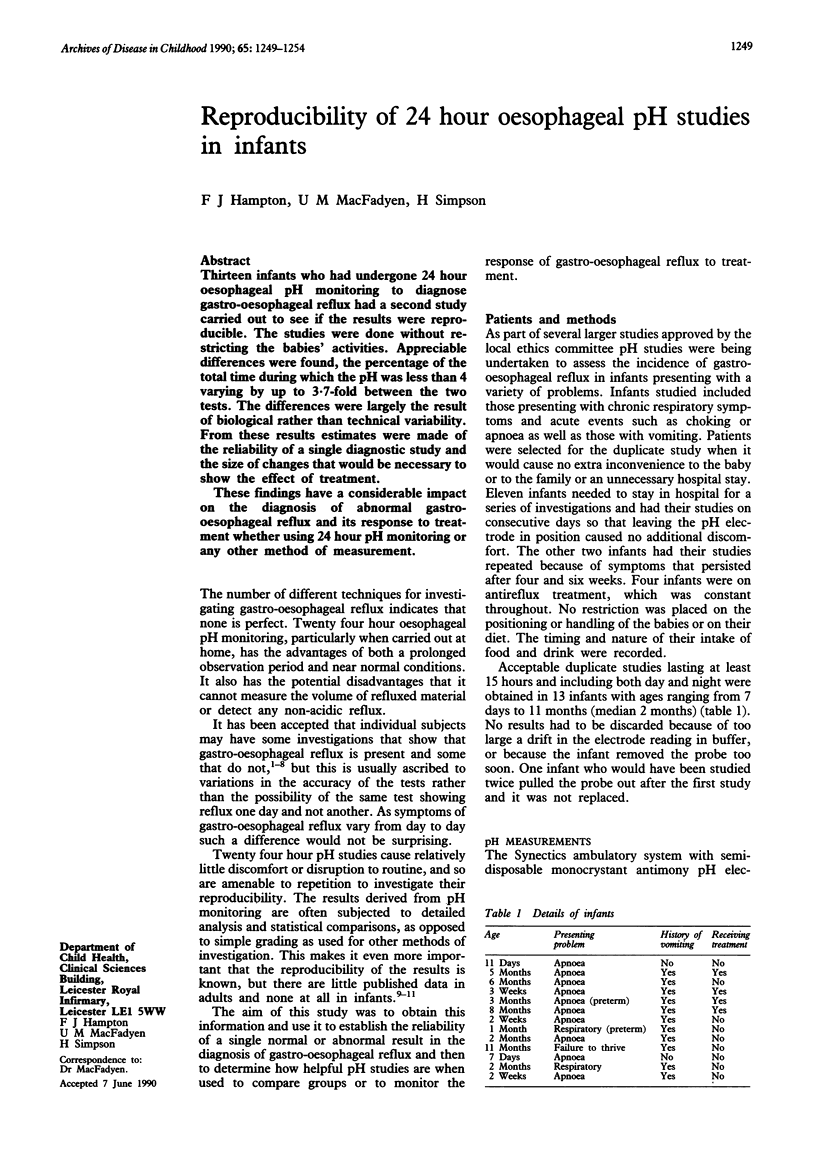
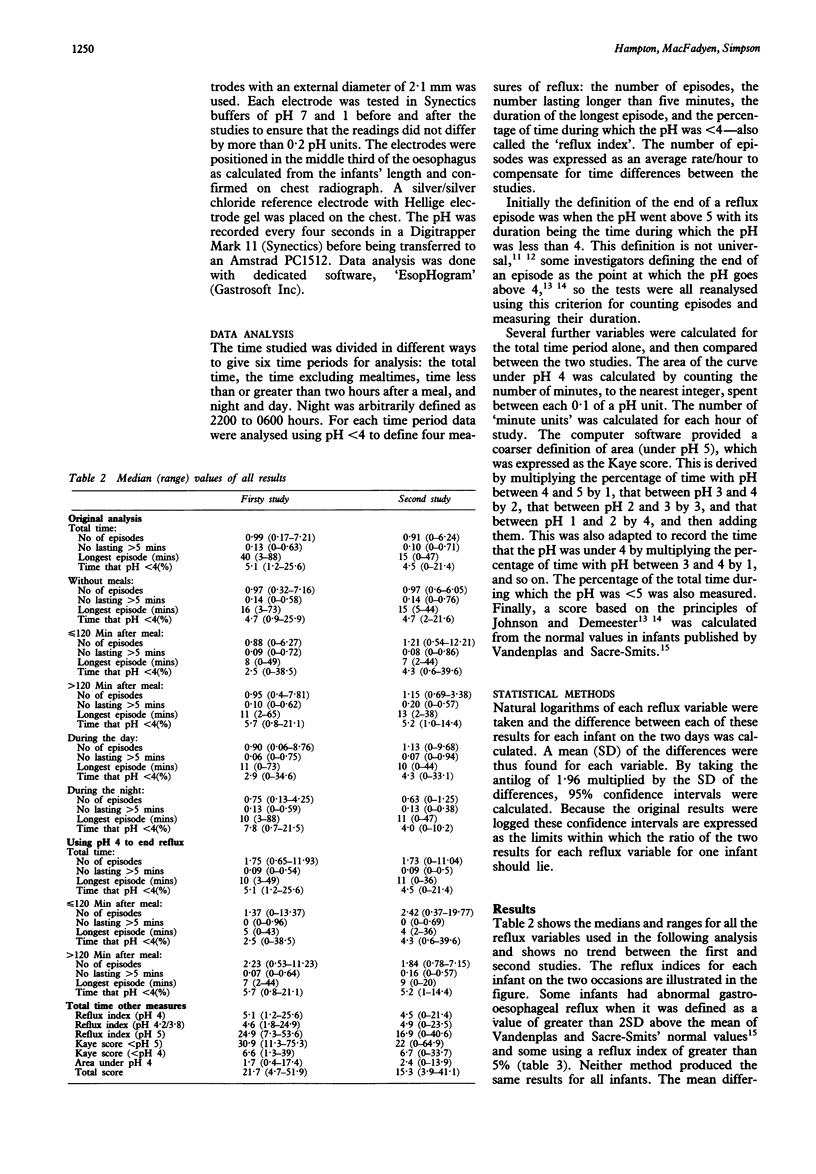
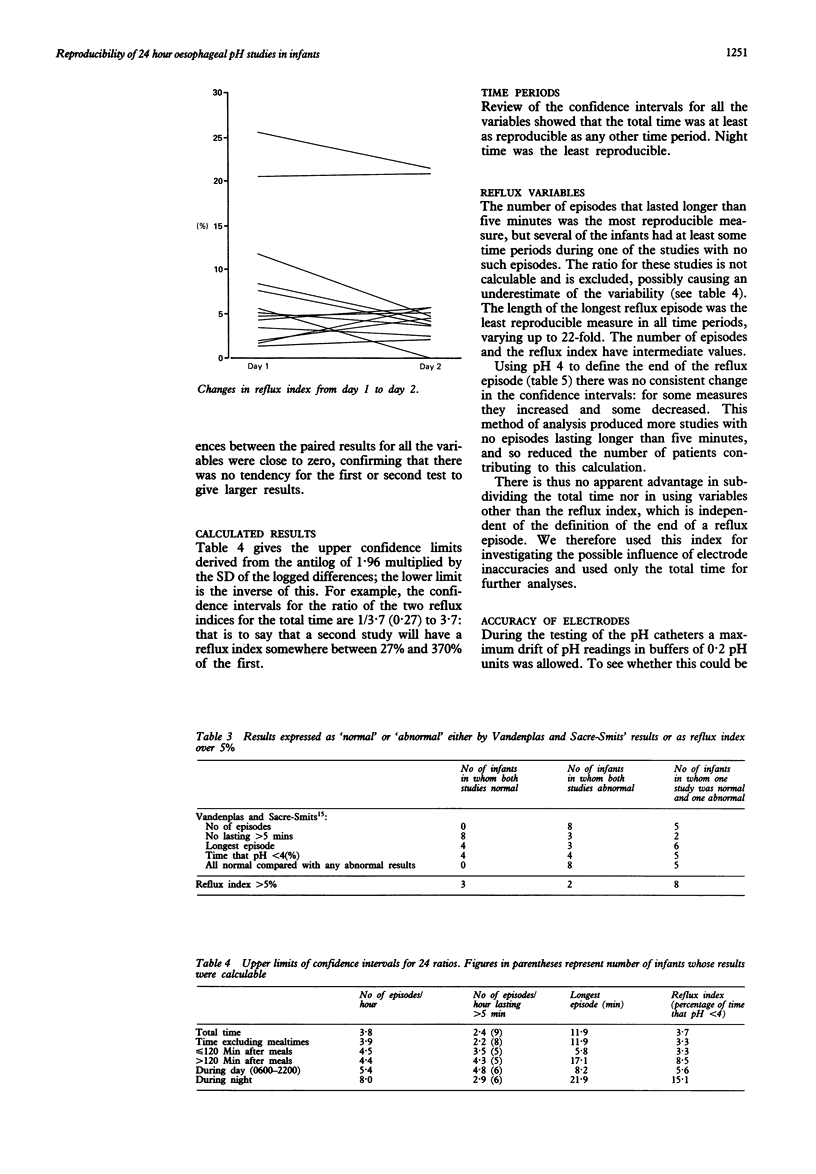
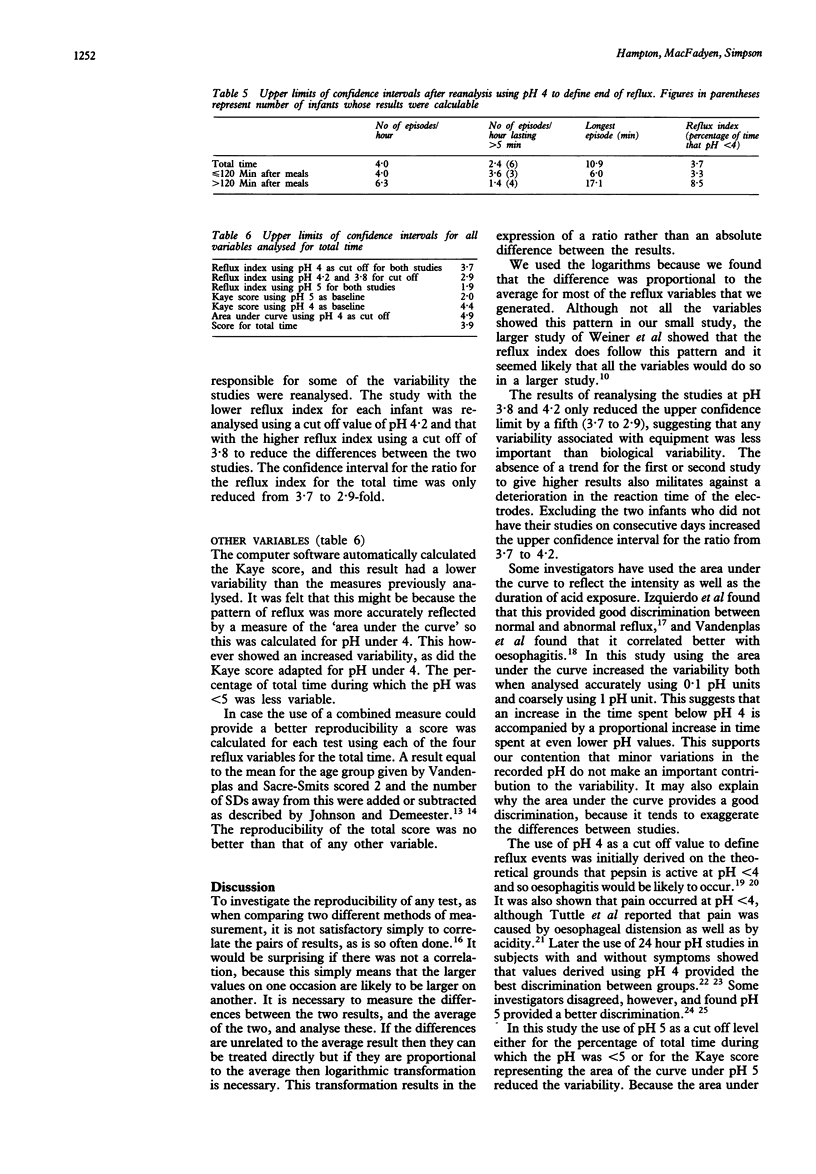

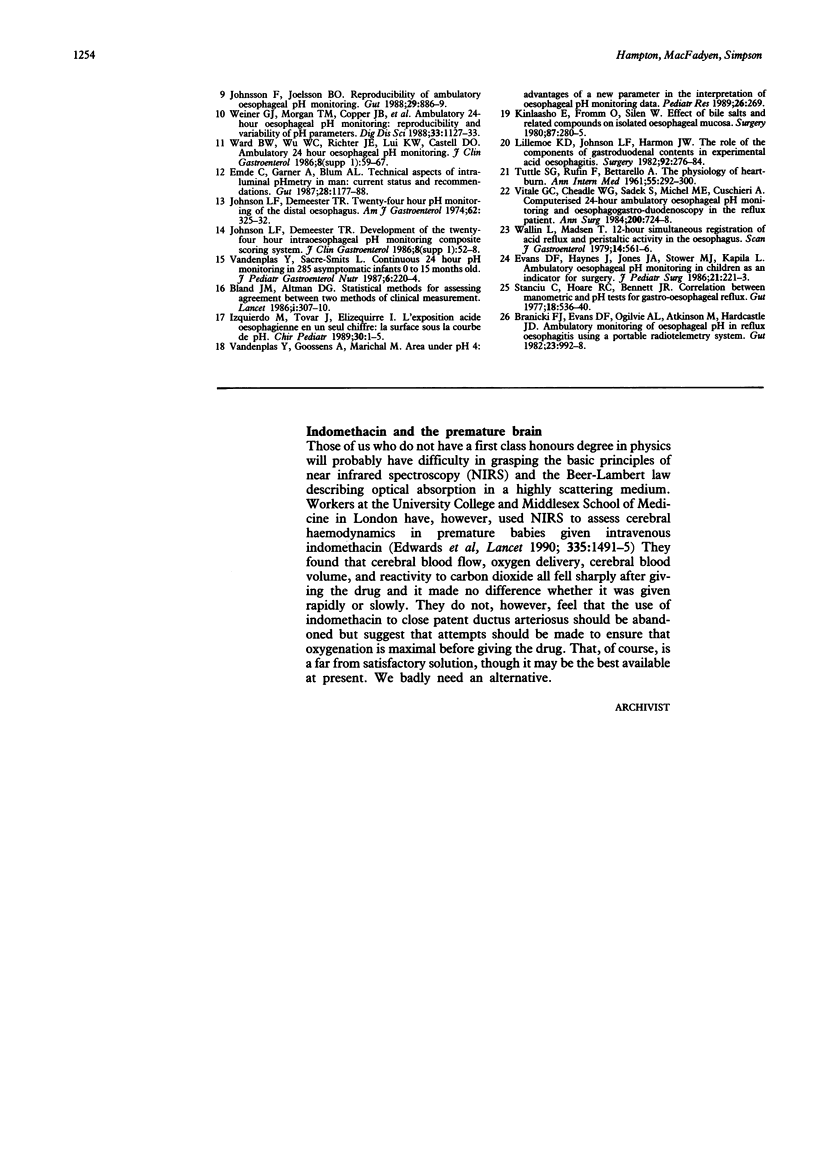
Selected References
These references are in PubMed. This may not be the complete list of references from this article.
- Branicki F. J., Evans D. F., Ogilvie A. L., Atkinson M., Hardcastle J. D. Ambulatory monitoring of oesophageal pH in reflux oesophagitis using a portable radiotelemetry system. Gut. 1982 Nov;23(11):992–998. doi: 10.1136/gut.23.11.992. [DOI] [PMC free article] [PubMed] [Google Scholar]
- Edwards A. D., Wyatt J. S., Richardson C., Potter A., Cope M., Delpy D. T., Reynolds E. O. Effects of indomethacin on cerebral haemodynamics in very preterm infants. Lancet. 1990 Jun 23;335(8704):1491–1495. doi: 10.1016/0140-6736(90)93030-s. [DOI] [PubMed] [Google Scholar]
- Emde C., Garner A., Blum A. L. Technical aspects of intraluminal pH-metry in man: current status and recommendations. Gut. 1987 Sep;28(9):1177–1188. doi: 10.1136/gut.28.9.1177. [DOI] [PMC free article] [PubMed] [Google Scholar]
- Evans D. F., Haynes J., Jones J. A., Stower M. J., Kapila L. Ambulatory esophageal pH monitoring in children as an indicator for surgery. J Pediatr Surg. 1986 Mar;21(3):221–223. doi: 10.1016/s0022-3468(86)80838-7. [DOI] [PubMed] [Google Scholar]
- Izquierdo M. A., Tovar J. A., Eizaguirre I. L'exposition acide oesophagienne en un seul chiffre: la surface sous la courbe de pH. Chir Pediatr. 1989;30(1):1–5. [PubMed] [Google Scholar]
- Johnson L. F., DeMeester T. R. Development of the 24-hour intraesophageal pH monitoring composite scoring system. J Clin Gastroenterol. 1986;8 (Suppl 1):52–58. doi: 10.1097/00004836-198606001-00008. [DOI] [PubMed] [Google Scholar]
- Johnson L. F., Demeester T. R. Twenty-four-hour pH monitoring of the distal esophagus. A quantitative measure of gastroesophageal reflux. Am J Gastroenterol. 1974 Oct;62(4):325–332. [PubMed] [Google Scholar]
- Johnsson F., Joelsson B. Reproducibility of ambulatory oesophageal pH monitoring. Gut. 1988 Jul;29(7):886–889. doi: 10.1136/gut.29.7.886. [DOI] [PMC free article] [PubMed] [Google Scholar]
- Kivilaakso E., Fromm D., Silen W. Effect of bile salts and related compounds on isolated esophageal mucosa. Surgery. 1980 Mar;87(3):280–285. [PubMed] [Google Scholar]
- Lillemoe K. D., Johnson L. F., Harmon J. W. Role of the components of the gastroduodenal contents in experimental acid esophagitis. Surgery. 1982 Aug;92(2):276–284. [PubMed] [Google Scholar]
- Stanciu C., Hoare R. C., Bennett J. R. Correlation between manometric and pH tests for gastro-oesophageal reflux. Gut. 1977 Jul;18(7):536–540. doi: 10.1136/gut.18.7.536. [DOI] [PMC free article] [PubMed] [Google Scholar]
- TUTTLE S. G., RUFIN F., BETTARELLO A. The physiology of heartburn. Ann Intern Med. 1961 Aug;55:292–300. doi: 10.7326/0003-4819-55-2-292. [DOI] [PubMed] [Google Scholar]
- Vandenplas Y., Sacré-Smits L. Continuous 24-hour esophageal pH monitoring in 285 asymptomatic infants 0-15 months old. J Pediatr Gastroenterol Nutr. 1987 Mar-Apr;6(2):220–224. doi: 10.1097/00005176-198703000-00010. [DOI] [PubMed] [Google Scholar]
- Vitale G. C., Cheadle W. G., Sadek S., Michel M. E., Cuschieri A. Computerized 24-hour ambulatory esophageal pH monitoring and esophagogastroduodenoscopy in the reflux patient. A comparative study. Ann Surg. 1984 Dec;200(6):724–728. doi: 10.1097/00000658-198412000-00009. [DOI] [PMC free article] [PubMed] [Google Scholar]
- Wallin L., Madsen T. 12-Hour simultaneous registration of acid reflex and peristaltic activity in the oesophagus. A study in normal subjects. Scand J Gastroenterol. 1979;14(5):561–566. doi: 10.3109/00365527909181390. [DOI] [PubMed] [Google Scholar]
- Ward B. W., Wu W. C., Richter J. E., Lui K. W., Castell D. O. Ambulatory 24-hour esophageal pH monitoring. Technology searching for a clinical application. J Clin Gastroenterol. 1986;8 (Suppl 1):59–67. doi: 10.1097/00004836-198606001-00009. [DOI] [PubMed] [Google Scholar]
- Wiener G. J., Morgan T. M., Copper J. B., Wu W. C., Castell D. O., Sinclair J. W., Richter J. E. Ambulatory 24-hour esophageal pH monitoring. Reproducibility and variability of pH parameters. Dig Dis Sci. 1988 Sep;33(9):1127–1133. doi: 10.1007/BF01535789. [DOI] [PubMed] [Google Scholar]


